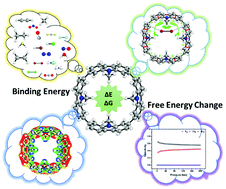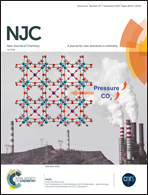Tetracyclo(9-methyl-2,7-carbazole) as a promising nanohoop for gas trapping: a multiscale study†
Abstract
The host–guest complexes of a recently synthesized tetracyclo(9-methyl-2,7-carbazole) (TCC) with several guest molecules, such as H2, H2O, H2S, CO, CO2, CS2, N2, NO, NO2, F2, Cl2, Br2, HF, HCl, HBr, CH4, C2H2, C2H4, and C2H6, were studied by using density functional theory. Functionalized symmetry-adapted perturbation theory (F-SAPT) was employed to determine the intermolecular interactions, which incorporated various binding energy components. The interactions were found to be mostly of the van der Waals type, predominantly including electrostatic and dispersion effects. A negative value of Gibbs free energy change (ΔG) revealed that the complex Br2@TCC was the most stable at room temperature (298.15 K) followed by HF@TCC and CS2@TCC. Other complexes were found to be stable at lower temperatures, as inferred from their ΔH and ΔS values. Grand Canonical Monte Carlo (GCMC) simulations were performed to predict the maximum gravimetric storage of the gas molecules in the TCC container and the selectivity of gas molecules from their respective congeners. The selectivity of Br2 was highest among all and H2S, CS2, NO2, HBr, and C2H6 selectivity was found to be higher under ambient conditions from their respective congeners.



 Please wait while we load your content...
Please wait while we load your content...